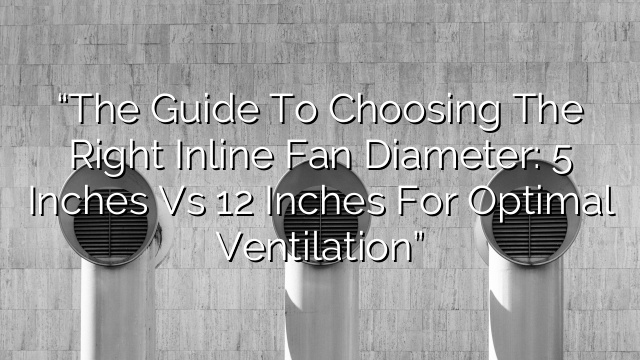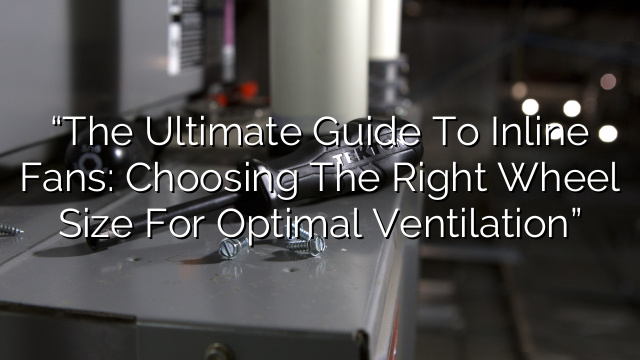- Introduction
- Importance of Ventilation in Indoor Spaces
- What is an Inline Fan?
- The Role of Inline Fans in Ventilation
- Understanding Inline Fan Diameter
- 5 Inches Diameter Inline Fan
- 12 Inches Diameter Inline Fan
- Factors to Consider When Choosing an Inline Fan Diameter
- Size of the Space
- Number of Vents
- Type of Grow Lights
- Benefits of Using a 5 Inches Diameter Inline Fan
- Efficient Ventilation for Small Spaces
- Lower Power Consumption
- Reduced Noise Levels
- Benefits of Using a 12 Inches Diameter Inline Fan
- Effective Ventilation for Large Spaces
- Increased Airflow Capacity
- Better Heat Dissipation
- Conclusion
- FAQs
Introduction
Ventilation is crucial for maintaining a healthy and comfortable indoor environment. Whether it’s a grow room, bathroom, or kitchen, adequate airflow is necessary to remove stale air, odors, and excess heat. Inline fans play a vital role in ensuring proper ventilation by efficiently moving air in and out of the space.
Importance of Ventilation in Indoor Spaces
Indoor spaces often suffer from poor air quality due to limited natural airflow. Proper ventilation helps remove airborne pollutants, allergens, and excess moisture, improving the overall indoor air quality. It also helps regulate temperature and prevent the buildup of odors, mold, and mildew.
What is an Inline Fan?
An inline fan, also known as a duct fan or exhaust fan, is a type of fan that is installed inside a duct to move air through the ductwork. Inline fans are commonly used in ventilation systems to extract air from a specific space, such as a grow room or bathroom, and expel it outside or into another area.
The Role of Inline Fans in Ventilation
Inline fans play a crucial role in maintaining proper airflow and ventilation in indoor spaces. They are typically connected to ductwork and can be used to extract air or supply fresh air to the space, depending on the specific ventilation requirements. Inline fans are designed to be energy-efficient, durable, and capable of moving large volumes of air.
Understanding Inline Fan Diameter
Inline fans come in different diameters, with 5 inches and 12 inches being the most common options. The diameter refers to the size of the fan’s inlet or outlet, which determines the amount of air it can move. Choosing the right diameter for your inline fan is essential to ensure optimal ventilation.
5 Inches Diameter Inline Fan
A 5 inches diameter inline fan is suitable for small to medium-sized spaces that require moderate airflow. It is commonly used in bathrooms, small grow tents, or ventilation systems with limited duct length. The smaller diameter allows for easier installation in tight spaces and is generally more affordable compared to larger fans.
12 Inches Diameter Inline Fan
A 12 inches diameter inline fan is suitable for larger spaces that require high airflow capacity. It is commonly used in commercial grow rooms, large industrial spaces, or ventilation systems with long duct runs. The larger diameter allows for increased air movement, making it more effective in large areas.
Factors to Consider When Choosing an Inline Fan Diameter
When choosing between a 5 inches diameter inline fan and a 12 inches diameter inline fan, several factors should be taken into consideration:
Size of the Space
The size of the space you need to ventilate is an essential factor in determining the right inline fan diameter. Smaller spaces, such as bathrooms or small grow tents, typically require a 5 inches diameter inline fan. Larger spaces, such as commercial grow rooms or industrial spaces, require a 12 inches diameter inline fan for effective ventilation.
Number of Vents
If you have multiple vents or ducts connected to your ventilation system, you may need a larger diameter inline fan to ensure sufficient airflow to all the vents. Higher airflow resistance caused by multiple vents can be overcome by using a 12 inches diameter inline fan, which has better air-moving capacity.
Type of Grow Lights
If you are using high-intensity grow lights in your grow room, such as HID or LED lights, they can generate a significant amount of heat. A 12 inches diameter inline fan is recommended in this case to improve heat dissipation and prevent the grow room from becoming too hot.
Benefits of Using a 5 Inches Diameter Inline Fan
Efficient Ventilation for Small Spaces
A 5 inches diameter inline fan is ideal for efficiently ventilating small spaces. It can effectively remove stale air, odors, and excess moisture from bathrooms, small grow tents, or other confined areas. The smaller diameter ensures that the fan doesn’t overpower the space while providing adequate ventilation.
Lower Power Consumption
5 inches diameter inline fans typically have lower power consumption compared to their larger counterparts. This can result in energy savings, especially in scenarios where continuous ventilation is required, such as in a bathroom or small grow room.
Reduced Noise Levels
Smaller diameter inline fans generally produce less noise compared to larger fans. If noise is a concern, such as in residential settings or areas where quiet operation is desired, a 5 inches diameter inline fan can be a suitable choice.
Benefits of Using a 12 Inches Diameter Inline Fan
Effective Ventilation for Large Spaces
A 12 inches diameter inline fan is designed to handle high airflow and effectively ventilate large spaces. Whether it’s a commercial grow room or an industrial area, a larger fan diameter ensures that sufficient air is circulated throughout the space, keeping it fresh and well-ventilated.
Increased Airflow Capacity
With a larger diameter, a 12 inches inline fan has a higher airflow capacity compared to a 5 inches diameter fan. This makes it suitable for applications where there are multiple vents or long duct runs, ensuring ample airflow to all areas connected to the ventilation system.
Better Heat Dissipation
If you are using high-intensity grow lights that generate a significant amount of heat, a 12 inches diameter inline fan is recommended to improve heat dissipation. The larger fan diameter enhances the fan’s ability to remove hot air, preventing heat from negatively affecting the plants’ growth.
Conclusion
Choosing the right inline fan diameter is essential for achieving optimal ventilation in indoor spaces. A 5 inches diameter inline fan is suitable for small to medium-sized spaces, while a 12 inches diameter inline fan is ideal for larger areas that require higher airflow capacity. Consider factors such as the size of the space, number of vents, and type of grow lights when selecting the appropriate fan diameter. Whether you choose a 5 inches or 12 inches diameter inline fan, proper ventilation will contribute to a healthier and more comfortable indoor environment.
FAQs
- What is the purpose of an inline fan?
Inline fans are used to extract air or supply fresh air in ventilation systems. They help remove stale air, odors, and excess moisture, improving indoor air quality and regulating temperature.
- Can a 5 inches diameter inline fan be used for a large grow room?
A 5 inches diameter inline fan may not provide sufficient airflow for a large grow room. It is recommended to use a 12 inches diameter inline fan for effective ventilation in larger spaces.
- Do inline fans consume a lot of power?
The power consumption of an inline fan depends on its size and specifications. Generally, 5 inches diameter inline fans have lower power consumption compared to 12 inches diameter fans.
- Are larger diameter inline fans noisier?
Larger diameter inline fans tend to produce more noise compared to smaller fans. However, there are high-quality fans available with noise-reduction features to minimize noise levels.
- Can a 12 inches diameter inline fan handle multiple vents?
A 12 inches diameter inline fan is designed to handle higher airflow and can effectively ventilate multiple vents or long duct runs.














